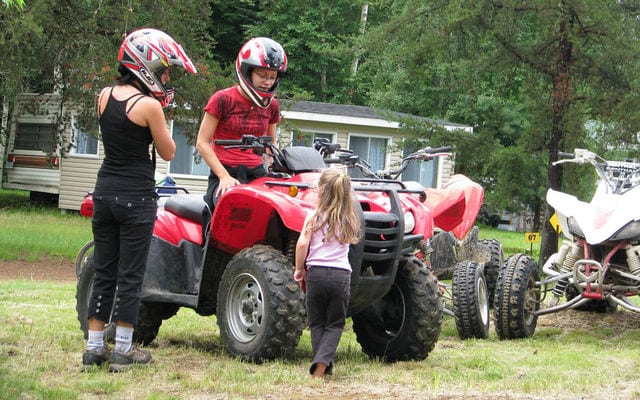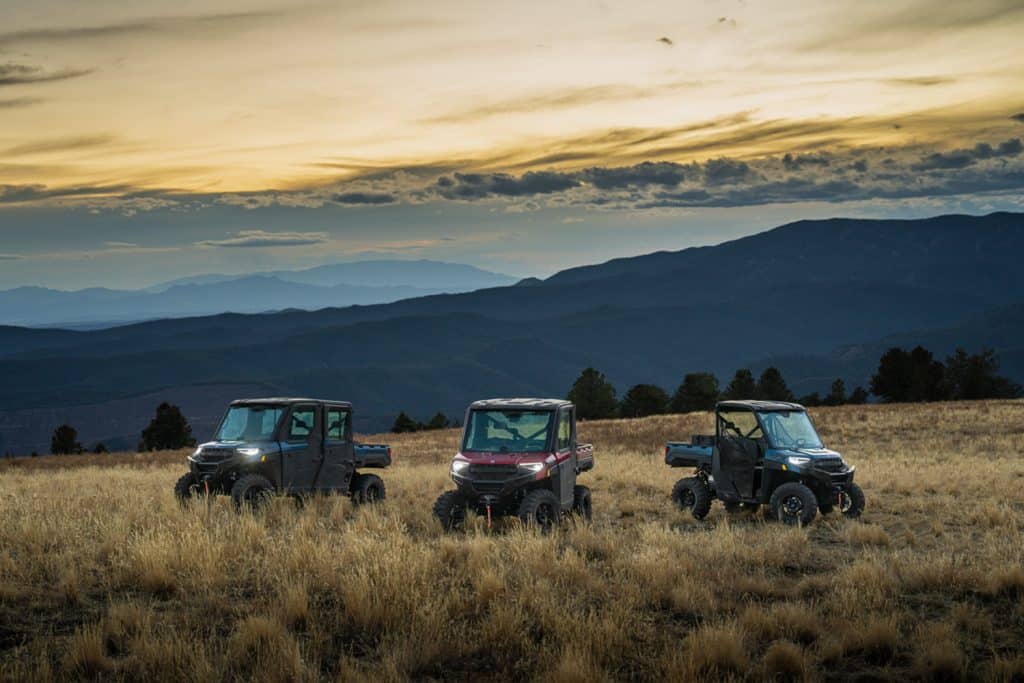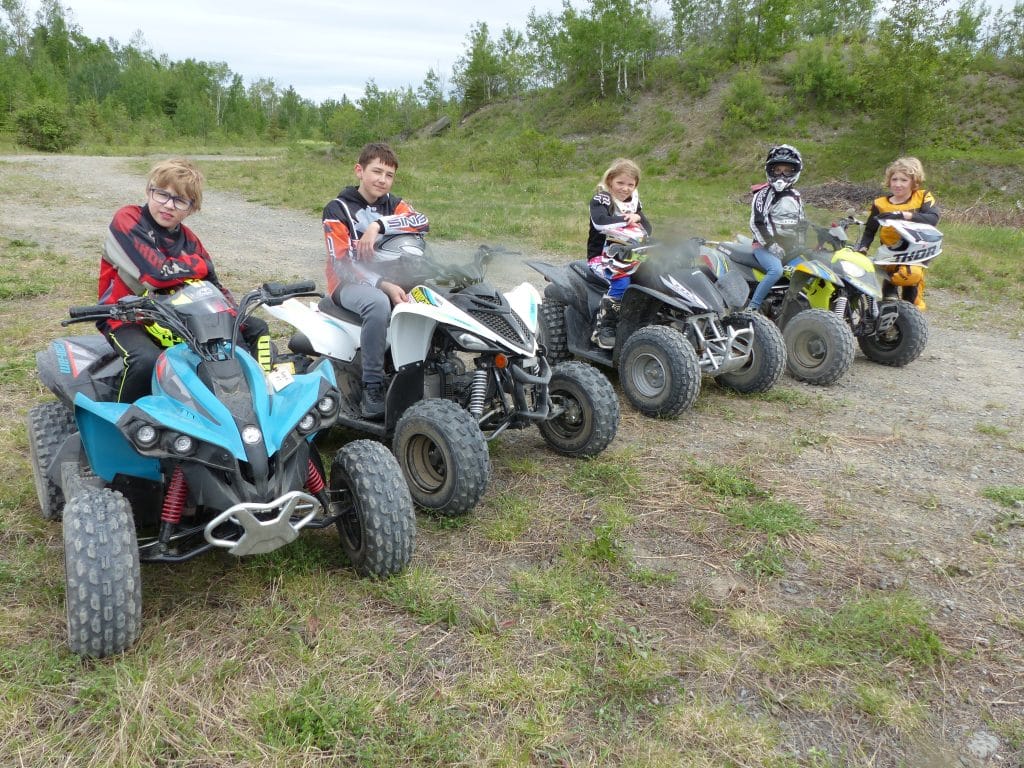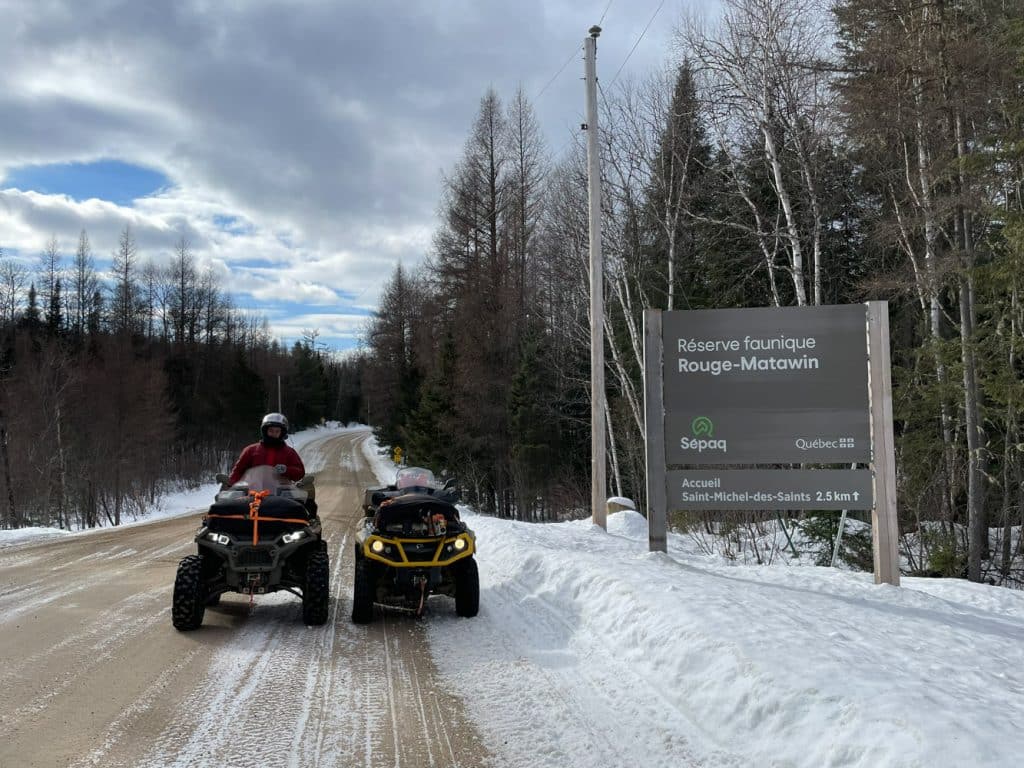All-Terrain Vehicle (ATV) use is an important activity to many people. Trail riding can be an immensely great experience when one is certain that many key factors were taken into consideration before venturing out into unknown territory. Actually, completely unknown trail systems should never be ventured out on. There are thousands of ATV trails with more being charted every day in the great Canadian outback.
First and foremost, nobody should ride an ATV without training, appropriate supervision, protective equipment, and a complete understanding of potential hazards and how to manage them. The very best way to really enjoy a fun and relaxing trail ride is to have someone to share knowledge of a known itinerary, and is willing to bring you along. This way, there is almost no possibility of getting lost, less risk of you getting stuck dealing with obstacles your skill level does not permit you to conquer or that un-willingly end up on land where your presence is not welcomed. For this reason, it’s a good idea to share all the details about your recent excursions with other four-wheeling enthusiasts through ATV forums on the web or in any other manner. After all, when you find a trail which is really exciting, sharing the news with your friends and other ATV fans is a gratifying gesture. The ball will surely be thrown back at you some day.
Things you might need
A minimum of cargo space should be available whenever venturing out for a long trail ride. If you are using a sports quad without any designated cargo space, at least bring a back-pack. There are a few things hardly taking up room to carry while having good potential to save your ride from doom. If your ride doesn’t have a winch, tie-downs can actually be useful to pull yourself out from a mud hole or can be used as a tow cable. Tie-wraps can come in handy for a myriad of emergency uses. Bring a small bicycle air pump (ATV tires need little pressure, so they can quickly be pumped back up with only a small hand-held pump), slow leaks are a frequent occurrence when trailing more aggressively, even more so if riding through a lot of rocky sections. Bent rims are often the cause of tire pressure loss. Your ATV should have its own basic tool kit; make sure it’s under your seat. Most important of all are the clothes you are wearing. Proper protective clothing includes boots, long pants, gloves, and good eye protection.
Always wear a helmet approved for ATV use, not for bicycle use. Research shows that a properly fitted helmet can decrease the risk of serious head injury by over 80%. Riding without the proper gear can not only be very uncomfortable, but downright dangerous, and even deadly in some situations. When out in cold weather, always prepare for the worst. It is better to have to stop and remove a layer, than start freezing when the temperature is dropping on you fast and leaving you with no other options but to suffer through it. Winter riding demands a whole new group of additional things you need to prepare for. Special attention should be given to your extremities, as they will be first to be affected by the cold. Extra socks and gloves kept dry are an absolute must and they take up hardly any cargo space. Of course, above all, your main precaution should be proper maintenance of your ATV being A-one. Make sure that it is in good running order. Never ride a machine which needs repair.
Ride long but stay close
Even if you want a long trail ride, you can do so without venturing too far from home. If you are a beginner you are better off staying reasonably close to home. First, check your local trail maps, there should be a club or organization in your area, which purpose is to inform and help you. You might just find all the necessary elements that make up a great and long trail ride, just a few miles from your own home. At the very least, start there, you might find suitable challenges, pretty landscapes, or whatever you fancy.
Venturing out into the unknown
Far from home, many more factors should taken into consideration and informing yourself as thoroughly as possible on everything there is to know about the region should be the first thing you do. In unknown territory, you should not ride as fast as usual and if you and your friends are far from emergency services, take extra care in your driving. Avoid tight turns, and when driving downhill, drive straight down rather than at an angle. When climbing uphill, you should stay in low gear to avoid a back flip. Do not turn suddenly, pop the clutch or rev the throttle too much. Ideally, you would ride with someone who is familiar with these trails. If this isn’t the case, at least try and talk to local riders and find out about trail conditions so you know what to expect.
Certain trails in hunting areas, might be closed for obvious safety reasons, Carrying a map of that area’s trail system will be absolutely necessary. Since you are further away, you will obviously be gone for a longer period. See to it that you bring enough of everything; make a checklist so you won’t forget anything. If you are not sure if a trail or area is opened to ATV users, don’t use it. You should wait until you have been given the o.k. by either the property owner or a legal authority before riding. Far too many ATV enthusiasts have given the sport a bad name by ripping on private property or tearing up on non-trail surfaces. There are plenty of legal ATV trails out there. You should always make sure the one you choose is commonly used. Enjoy the natural surroundings while respecting them. Don’t forget to always let someone know where you are going and the approximate time you intend to be back.
Legal aspects
Currently in Canada, ATV laws vary by jurisdiction and by location of use. Municipal authorities may enact by-laws regulating the use of ATVs within their jurisdiction. You should get information from your local municipality for any related ATV by-laws. ATV users do have a responsibility to be informed. On some occasions, where a municipality is host to a big ATV related event, special permissions are put in place for limited periods of time where use of ATV on public roads or bicycle paths are allowed. One such example is during festivities surrounding the annual 12 hour endurance race in LaTuque,Quebec, when for the entire week the town becomes ATV friendly. Users are expected to follow all normal traffic regulations as they would with any other road vehicle and strict supervision is practiced by police forces.
In British Columbia, there is no provincial legislation for recreational use of an All-Terrain Vehicle. ATVs for farming or industrial use must be registered and children under 16 can not register an ATV.
In Alberta, children under 14 years cannot operate an ATV on a highway. Children under 14 years cannot operate an ATV on public property unless they are supervised by an adult who is 18 years of age or older and who occupies the passenger seat of the ATV or is following in close proximity the ATV. Helmet use is not mandatory.
In Saskatchewan, one must have permission to operate an ATV on private land. Children under 16 years can operate an ATV on land owned by an immediate family member. Children ages 12-15 years can operate an ATV on public or private property, provided they have passed an approved ATV training course; are accompanied on the ATV or are supervised by an adult who has held continuously for the immediate preceding 365 days, a permit to operate an ATV or have passed an approved safety training course. Children ages 12-15 years can operate an ATV on the non-travel portion of the highway or for the purpose of crossing a highway to the shortest route available. Helmet use is mandatory but not when operating on land owned by an immediate family member.
In Manitoba, children under 14 years can operate an ATV if they are supervised by a parent or an adult who is at least 18 years of age (and authorized by the parent) and is in clear view of the ATV during operation. Helmet use is mandatory but does not apply when operating an ATV for the purpose of farming, commercial fishing, hunting or trapping.
In Ontario, children under 12 years cannot operate an ATV unless they are operating the ATV on land owned by the vehicle’s owner or are closely supervised by an adult. The minimum operating age for ATV use on roads or crossing roads is 16 years. Helmet use is mandatory but does not apply when operating an ATV on land occupied by the ATV owner.
In Quebec, minimum driver age is 16 years for adult sized ATVs. Children under 16 years can operate youth sized ATVs as approved by regulation. Children under 16 may operate an ATV on competition circuits as approved by regulation under the Minister of Education, Recreation and Sport. Driver safety training is mandatory for ages 16-17, they must obtain certificate of competency. Wearing a helmet is mandatory.
In New Brunswick, children under 14 years can operate an ATV provided that they are supervised by an adult who is 19 years of age or older. Children under 16 must complete an approved safety training course to operate an ATV. Helmet use is mandatory.
In Nova Scotia, the minimum driver age is14 years old. Children 14-15 require direct parental/guardian supervision to operate ATVs and both child and parent/guardian need to complete an approved safety training course. Children under 14 can operate an ATV in a closed course provided they are supervised by an adult, have completed an approved safety training course, are wearing protective equipment, are operating an ATV that is fit for their age, size and capability and a trained official and trained first respondent are present. Helmet use is mandatory.
In Prince Edward Island, the minimum driver age is 14 years old. To operate an ATV, children ages 14-15 years must have completed an approved safety training course and be directly supervised by an adult who either holds a valid driver’s license for at least 24 months prior to supervising or has completed an approved safety training course. Persons over the age of 16 years must have a valid driver’s license for at least 2 years or have completed an approved safety training course to operate an ATV. Wearing a helmet is mandatory.
In Newfoundland and Labrador, the minimum driver age is 14 years old. Children under 16 years cannot operate a full-size ATV. Children 14-15 years can operate a 90 cc or less (youth sized) ATV provided they are supervised by an adult who is 19 years of age or older. Supervision must consist of visual and voice communication with the operator. Wearing a helmet is mandatory.
In Yukon, there is no provincial legislation regarding the operation of All-Terrain Vehicles.
In the Northwest Territories, minimum driver age is 14 years to drive on highway. The same goes in Nunavut.
With this knowledge and more that you should be in constant search of, it should make for unforgettable rides. Enjoy this immensely trail rich country of ours in a safe, logical and respectful manner, so that generations to come can practice this amazingly entertaining activity that is ATV trail riding. Happy trails!





